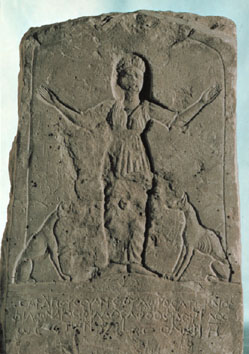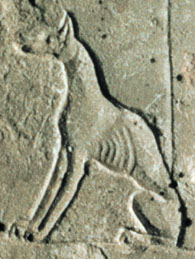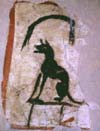Limestone stele depicting a female figure in Greek dress flanked by two jackals. The inscription on the stele reads: "Sarapous, daughter of Euanthes, died before her time, childless, devoted to her husband, fond of her sister, fond of her friends, about 14 years old. Year 6, Phaophi 8."

KM 21069: Limestone Stele of Sarapous
Terenouthis, Egypt
The inscription is short and of a generally poor quality. It tells only the name and age of the deceased.
This grave marker is made of limestone and cut in hollow relief. The stele bears a central standing female figure. Her arms extend at right angles from her body and are bent at the elbow with the forearms held upward in the 'orans' pose: a common position that shows communication with the gods. The figure is clothed in an Ionic chiton, overlaid by a Doric-style chiton that extends to just below the waist and is tied under the breasts with a belt. The hair is indicated by incised lines, parted in the middle and brought back from the forehead. The clothing is clearly Greek, but the representation of the hair, and of the legs in profile, are in an Egyptian style. The mixture of Greek and Egyptian styles on the stele shows the combination of the two traditions in a workable compromise which was well suited to meet the demands of a mixed population in Roman Egypt.

